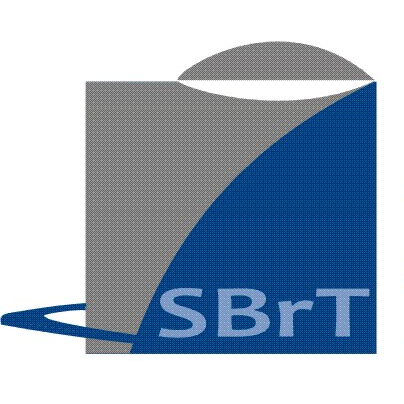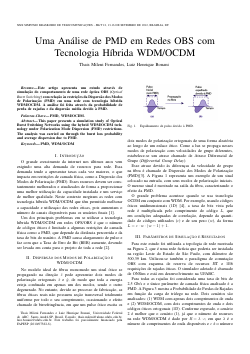
XXX Simpósio Brasileiro de Telecomunicações

Novel Automatic Modulation Classification using Correntropy Coefficient
Aluisio I. R. Fontes, Lucas C. P. Cavalcante, Luiz F. Q. Silveira
DOI: 10.14209/sbrt.2012.141
Keywords: Correntropy Coefficient Automatic Modulation Classification Radio Cognitivo
Abstract
Correntropy Coefficient, Automatic Modulation Classification, Radio CognitivoDownload

Avaliação de diferentes métodos de inferência da demanda por banda do algoritmo de DBA no desempenho de redes XG-PON
Sandro Marcelo Rossi, Mariela Mayumi F. Sasaki
DOI: 10.14209/sbrt.2012.142
Keywords: XG-PON DBA traffic prediction neural network
Abstract
This article presents a DBA algorithm and the comparison among four methods of determining one of its inputs, the bandwidth demand. For the performance evaluation, we used a XG-PON implemented in the OMNet++ simulation framework. The four methods are: conventional Status Report (SR) and Traffic Monitoring (TM), and TM-based prediction using a simple linear regression and a time-delay neural network. All evaluated methods have shown adequate QoS for triple-play services.Download

Mapas de profundidade de superfícies texturizadas baseados em Depth Hallucination
José Almeida Jr, Mariane R. Petraglia e José, Gabriel R. C. Gomes
DOI: 10.14209/sbrt.2012.143
Keywords: Depth Hallucination Depth Map Albedo Shading Map CSharp
Abstract
This work has as main goals in research, evaluation and test of the Depth Hallucination process: capture the images, image processing and surface depth visualization. Using the C# (CSharp) programming language, we developed a software that contains all algorithms of this technique and presents a friendly and simple interface. This allows that the good results from the technique could be used by professionals from different areas, such as visual effects, architecture and games.Download

A Distance-based Study for Device-to-Device Communication Underlaying a Cellular System
Henrique de H. M. Barros, Márzio G. S. Rêgo, Evilásio O. Lucena, Tarcisio F. Maciel, Walter C. Freitas Jr., F. Rodrigo P. Cavalcanti
DOI: 10.14209/sbrt.2012.144
Keywords:
Abstract
The increasing demand for rich multimedia services and the scarcity of radio resources has motivated the research of technologies able to increase wireless systems’ capacity without requiring additional spectrum. In this context, direct Device-toDevice (D2D) communication between User Equipments (UEs) is a promising technology. By allowing direct low-power communication among UEs, D2D communication leads to intelligent spatial reuse of radio resources, permits to offload the network and to increase its capacity and/or Quality of Service (QoS) levels. In this work, we provide a brief literature review on D2D communication, identify and discuss key issues related to the potential benefits of D2D communication within a cellular system, as well as present a distance-based study for defining scenarios in which D2D communication can increase the overall system capacity.Download

Implementação Eficiente de Filtros de Hammerstein Adaptativos Usando o Algoritmo NLMS
Eduardo Luiz Ortiz Batista, Rui Seara
DOI: 10.14209/sbrt.2012.145
Keywords: Adaptive filters nonlinear filters Hammerstein filters NLMS algorithm
Abstract
This paper presents a novel strategy to implement adaptive Hammerstein filters aiming to circumvent numerical problems arising from the cascade adaptive process inherent to these filters. Such problems are often overcome maintaining one of the filter coefficients fixed, which may significantly impair the convergence speed of the adaptive algorithm. The proposed strategy uses a coefficient normalization procedure, which avoids maintaining one of the coefficients fixed and thus permits to obtain a faster convergence speed. As a result, an adaptive algorithm with very good performance and acceptable computational cost is obtained. Simulation results are presented attesting the effectiveness of the proposed strategyDownload

Uma Análise de PMD em Redes OBS com Tecnologia Híbrida WDM/OCDM
Thais Mileni Fernandes, Luiz Henrique Bonani
DOI: 10.14209/sbrt.2012.146
Keywords: PMD WDM/OCDM
Abstract
This paper presents a simulation study of Optical Burst Switching Networks using the hybrid WDM/OCDM technology under Polarization Mode Dispersion (PMD) restrictions. The analysis was carried on through the burst loss probability and average dispersion due to PMDDownload

Algoritmo com Ganho Proporcional ao Desvio Médio Quadrático dos Coeficientes Baseado na Autocorrelação do Erro
Fábio Luis Perez, Francisco das Chagas de Souza, Rui Seara
DOI: 10.14209/sbrt.2012.147
Keywords: Error autocorrelation echo cancellation adaptive filtering system identification.
Abstract
This paper presents a new adaptive algorithm alternative to the mean-square weight deviation-proportionate ( -proportionate) z2 algorithm. The latter combines a mean-square weight deviation-proportionate gain distribution with a uniform one. Such a strategy is strongly dependent on the measurement noise power level that, in practice, is not readily available. Aiming to circumvent such dependence, a new strategy of gain distribution based on error autocorrelation is discussed here. The proposed algorithm outperforms the original one (z2-proportionate). Through simulation results, the effectiveness of the new algorithm is assessed.Download

Application of Dynamic Clustering into CoMP Systems
E. M. G. Stancanelli, T. F. Maciel, Y. C. B. Silva, W. C. Freitas Jr., F. R. P. Cavalcanti
DOI: 10.14209/sbrt.2012.221
Keywords: CoMP Assignment algorithm Clustering.
Abstract
In the last few years, advanced multi-antenna systems attracted a lot of interest as a means to improve the spectral efficiency of conventional cellular networks. This is the case of Coordinated Multi-Point (CoMP) systems in the context of 3rd Generation Partnership Project (3GPP) Long Term Evolution (LTE). However, the large amount of signaling required to achieve a full coordinated transmission is somewhat worrying. Performing the coordination within clusters of Transmission Points (TPs) rather than within the whole set of TPs can be an alternative to lighten the signaling and processing required. In this work, we introduce the Clustering-based Assignment Algorithm (CbAA) to cluster dynamically the TPs for transmitting coherently to multiple selected User Equipments (UEs). In fact, this approach will result in some loss of spectral efficiency, however, depending on the application requirements, the signaling shrinkage is so significant as to justify its use.Download

A Novel Meteorological Radar Scheme based on the Correlation between Fixed Antennas: a First Look
Marco Antonio Miguel Miranda, José Cândido Silveira Santos Filho, Gustavo Fraidenraich, Michel Daoud Yacoub, João Roberto Moreira Neto, and Yusef Cáceres Zúñiga
DOI: 10.14209/sbrt.2012.148
Keywords: Baseline correlation coefficient radar scattering
Abstract
The purpose of this paper is to derive a general analytical expression for the correlation coefficient of signals received by two different antennas as a function of the distance between them (baseline distance), the signal bandwidth, and the antenna beamwidth. The two antennas are supposed to be part of a radar system for detecting meteorological phenomena such as rain and clouds. One of the antennas transmits the radar signal and receives the echoes; the other antenna only receives the echoes. The good functioning of such a radar system depends on the correlation between the two antenna signals. The exact analytical framework derived here has been recently used in practice to assist in the design of a meteorological radar system for Orbisat Indústria e Aerolevantamento S.A.Download

Reticulados q-ários na norma lp e uma generalização da métrica de Lee
Antonio Campello, Grasiele C. Jorge, Sueli I. R. Costa
DOI: 10.14209/sbrt.2012.149
Keywords: Reticulados Códigos Corretores de Erros Métrica de Lee
Abstract
Reticulados q-ários são obtidos através da Construção A de códigos lineares q-ários. Neste trabalho, mostramos que no estudo de tais reticulados munidos da métricas lp, surge naturalmente uma nova metrica no conjunto Znq, a qual chamamos métrica p-Lee. Para p = 1, esta métrica é a chamada métrica de Lee, largamente estudada na literatura. Para 1 < p ≤ 1, generalizamos um resultado sobre decodificação de reticulados na métrica de Lee e discutimos brevemente sobre a existência de códigos perfeitos em tais métricas, estabelecendo uma caracterização de todos os códigos perfeitos quando p = 1 e algumas propriedades para o caso geral.Download